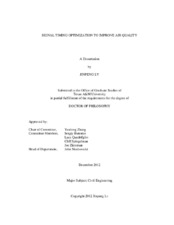| dc.description.abstract | This study develops an optimization methodology for signal timing at intersections to reduce emissions based on MOVES, the latest emission model released by U.S. Environmental Protection Agency (EPA). The primary objective of this study is to bridge the gap that the research on signal optimization at intersections lags behind the development of emissions models. The methodology development includes four levels: the vehicle level, the movement level, the intersection level, and the arterial level.
At the vehicle level, the emission function with respect to delay is derived for a vehicle driving through an intersection. Multiple acceleration models are evaluated, and the best one is selected in terms of emission estimations at an intersection. Piecewise functions are used to describe the relationship between emissions and intersection delay.
At the movement level, emissions are modeled if the green time and red time of a movement are given. To account for randomness, the number of vehicle arrivals during a cycle is assumed to follow Poisson distributions. According to the numerical results, the relative difference of emission estimations with and without considering randomness is usually smaller than 5.0% at a typical intersection of two urban arterials.
At the intersection level, an optimization problem is formulated to consider emissions at an intersection. The objective function is a linear combination of delay and emissions at an intersection, so that the tradeoff between the two could be examined with the optimization problem. In addition, a convex approximation is proposed to approximate the emission calculation; accordingly, the optimization problem can be solved more efficiently using the interior point algorithm (IPA). The case study proves that the optimization problem with this convex approximation can still find appropriate optimal signal timing plans when considering traffic emissions.
At the arterial level, emissions are minimized at multiple intersections along an arterial. First, discrete models are developed to describe the bandwidth, stops, delay, and emissions at a particular intersection. Second, based on these discrete models, an optimization problem is formulated with the intersection offsets as decision variables. The simulation results indicate that the benefit of emission reduction become more and more significant as the number of intersections along the arterial increases. | en |


